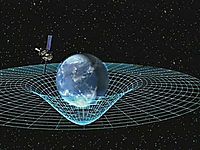
Photo from wikipedia
Underwater acoustic (UWA) communication is the only option for underwater long-distance wireless communication. However, its data rate is very low, in tens of kbps, and the time-varying nature of the… Click to show full abstract
Underwater acoustic (UWA) communication is the only option for underwater long-distance wireless communication. However, its data rate is very low, in tens of kbps, and the time-varying nature of the UWA channel exhibits a Doppler effect. The data rate can be increased using a multicarrier technique, such as Filter Bank Multicarrier (FBMC). The FBMC-OQAM system does not require a cyclic prefix (CP) to eliminate intersymbol interference (ISI). Therefore, compared to other multicarrier techniques, the FBMC-OQAM system achieves the maximum spectral efficiency. Despite the well-designed filter, synchronisation errors cause performance degradation in the FBMC-OQAM system. In this paper, we propose frame boundary and Doppler frequency estimation methods for the FBMC-OQAM system under UWA channels. In this study, we propose a preamble-based frame boundary. The conjugate symmetry property is used in the frame boundary estimation. The performance of the proposed technique was studied under different UWA channels with different Doppler scale. The proposed time synchronisation technique yielded multiple peaks under UWA channels. A method for identifying the peak that represents the frame boundary is proposed. We compared the performance of proposed timing metric with Schmidl & Cox timing metric and Reddy.s timing metric. The proposed timing metric exhibited superior performance over existing techniques. In addition, we propose a convolutional neural network (CNN)-based Doppler scale estimation method. The proposed technique was shown to estimate a wide range of Doppler scale factors. The performance of the proposed technique was studied by considering different UWA channels at different SNRs. The proposed CNN architecture is analysed by changing the CNN parameters. Stacked autoencoders were adopted for Doppler scale estimation and the performance of the proposed CNN-based Doppler scale estimation method was compared with the stacked autoencoders based Doppler scale estimation method. Simulation results show that the proposed CNN-based Doppler Scale estimator exhibits good performance in UWA channels at different SNRs and Doppler scale factors.
Journal Title: IEEE Access
Year Published: 2022
Link to full text (if available)
Share on Social Media: Sign Up to like & get
recommendations!